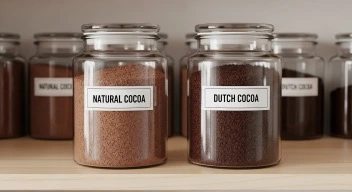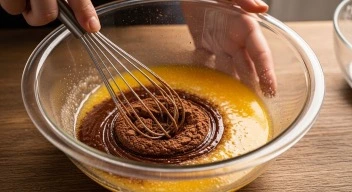We’ve all been there. You reach into the pantry, find that half-used tin of cocoa powder from last winter’s baking spree, and wonder — is this still okay to use? It doesn’t exactly smell off, but it’s been sitting there for months, maybe even years. Does cocoa powder go bad, or does it just lose flavor over time?
The short answer: cocoa powder doesn’t spoil the way milk or fruit does, but it can lose its quality, potency, and taste if stored improperly or kept too long.
Whether you’re a passionate baker, a hot chocolate lover, or just someone curious about the shelf life of pantry staples, understanding how cocoa behaves over time can save you from disappointing desserts — and wasted ingredients.
Let’s dive into everything you need to know about cocoa powder’s shelf life, how to tell if it’s still good, how to store it properly, and what happens when it starts to decline.
What Exactly Is Cocoa Powder?
Cocoa powder is made from fermented, roasted cacao beans that have been ground and had most of their cocoa butter removed. What remains is a dry, concentrated powder filled with flavor, natural fats, and antioxidants.
There are two main kinds of cocoa powder:
- Natural cocoa powder: lighter in color, slightly acidic, and full of unaltered flavonoids (the beneficial antioxidants in chocolate).
- Dutch-processed cocoa: treated with alkali to neutralize acidity, creating a smoother flavor and darker color, but with a slightly shorter antioxidant life span.
These differences affect both flavor and storage life, so knowing which type you have matters when assessing freshness.
To learn more about how cocoa processing changes its health value, read Health Benefits of Cocoa Powder: Antioxidants, Energy, and More.
Does Cocoa Powder Expire?
Technically, cocoa powder does not “expire” in the same way perishable foods do. It won’t become unsafe or grow bacteria under normal conditions because it contains very little moisture — and microbes need water to thrive.
However, cocoa can degrade over time due to oxidation, humidity, or exposure to heat and light. The oils that remain in the powder may become stale, causing off-flavors or a dull aroma.
So, while cocoa powder won’t make you sick if it’s old, it can make your brownies or hot chocolate taste disappointing.
According to NIH, the lipid oxidation rate in cocoa depends heavily on storage temperature and air exposure — higher heat accelerates rancidity.
Shelf Life of Cocoa Powder
Most store-bought cocoa powder comes with a “best by” date, usually 2–3 years from the production date. This is not an expiration date; it’s a manufacturer’s estimate of when the powder will taste best.
Here’s a general guide:
| Storage Type | Shelf Life (Unopened) | Shelf Life (Opened) |
| Pantry (cool, dry place) | 2–3 years | 1–2 years |
| Refrigerator (airtight container) | 3 years | 2 years |
| Freezer (airtight container) | Up to 3 years | Up to 2 years |
Note: Keeping cocoa in the fridge or freezer can extend freshness slightly, but only if sealed well. Moisture is cocoa’s enemy — even a small amount of condensation can cause clumping or mold.
For more storage insights, visit our guide How to Store Chocolate to Keep It Fresh: Tips from Experts.)
How to Tell If Cocoa Powder Has Gone Bad
You can’t rely solely on the date printed on the package. Use your senses — smell, sight, touch, and taste — to judge quality.
1. Smell
Fresh cocoa has a strong, deep chocolate aroma — earthy, slightly bitter, and rich.
If it smells faint, dusty, or like cardboard, the volatile oils have broken down. A sour or musty smell may indicate moisture damage or contamination.
2. Color
Fresh cocoa is a consistent, deep brown. Over time, oxidation can make it appear dull or faded.
Dutch-processed cocoa starts dark but can shift toward grayish brown when it’s old.
3. Texture
Rub a small pinch between your fingers. It should feel smooth and powdery.
If it feels clumpy or greasy, moisture has entered the container, which means the powder may not blend properly in recipes.
4. Taste
Mix a half-teaspoon in warm water or milk. It should taste intensely chocolatey and slightly bitter — not flat, sour, or stale.
If it tastes weak, that’s a clear sign it has lost its potency.
Why Cocoa Powder Loses Its Flavor
Cocoa’s flavor and nutritional value come from natural compounds that degrade over time:
- Flavonoids and polyphenols: antioxidants that oxidize when exposed to air.
- Theobromine and caffeine: mild stimulants that lose potency gradually.
- Trace cocoa butter fats: these can turn rancid if stored in warm or humid environments.
This chemical breakdown doesn’t make cocoa unsafe, but it alters the sensory profile — dull flavor, less aroma, and lower nutritional content.
Cocoa’s antioxidant activity can decrease by 60% after long-term air exposure at room temperature.
Proper Storage Tips to Keep Cocoa Powder Fresh
Does cocoa powder go bad

Does cocoa powder go bad
Cocoa’s shelf life depends more on storage habits than on the printed date. Here’s how to make it last:
- Keep it airtight. After each use, reseal the container tightly. Oxygen causes oxidation.
- Avoid moisture. Store in a cool, dry place away from sinks, stoves, or dishwashers.
- Maintain consistent temperature. Fluctuations cause condensation, which ruins cocoa’s texture.
- Skip the fridge unless necessary. Refrigerators often have high humidity. If you do refrigerate, double-seal it in an airtight jar and a plastic bag.
- Label and rotate. Note the opening date on the container so you can track freshness.
For longer storage advice and recipes that revive older cocoa, check Easy No-Bake Chocolate Desserts for Every Occasion.
Can You Still Use Expired Cocoa Powder?
Yes — in most cases, you can safely use cocoa powder that’s past its “best by” date if it looks, smells, and tastes normal. The main difference will be flavor intensity, not safety.
If your cocoa is over three years old but stored well, try this test: mix a teaspoon into hot milk. If it still smells chocolatey and tastes rich, it’s fine to use. If it tastes dull, it’s time to replace it.
You can also use slightly stale cocoa for non-food purposes:
- Natural dye for crafts
- Face or body scrubs (combined with sugar and coconut oil)
- Compost for plants (in small amounts)
The Nutritional Decline Over Time
As cocoa ages, its flavonoid and antioxidant levels drop gradually. This means older cocoa won’t deliver the same heart-healthy or anti-inflammatory benefits as fresh powder.
Still, even older cocoa retains some minerals like magnesium, iron, and potassium. So while its nutritional punch fades, it doesn’t disappear entirely.
For more about cocoa’s nutritional properties, see Health Benefits of Cocoa Powder: Antioxidants, Energy, and More.
The Difference Between Spoiled and Stale Cocoa
It’s important to distinguish between cocoa that’s stale (flavorless but safe) and cocoa that’s spoiled (unsafe to use).
| Condition | Cause | Safe to Use? |
| Dull flavor | Age or air exposure | Yes |
| Weak aroma | Loss of volatile oils | Yes |
| Mold or dark spots | Moisture exposure | No |
| Sour or bitter odor | Rancid fats | No |
| Clumping or sticky texture | Humidity | No |
If in doubt, toss it. Cocoa is inexpensive — it’s not worth risking the taste (or safety) of your next dessert.
How to Revive Slightly Old Cocoa Powder
Does cocoa powder go bad

Does cocoa powder go bad
If your cocoa has lost some flavor but is still usable, you can bring back depth with a few tricks:
- Bloom the cocoa. Heat it gently in melted butter or oil before adding to recipes — this intensifies flavor.
- Add espresso powder. A pinch of coffee enhances chocolate flavor naturally.
- Use more cocoa. Increase the amount by 10–15% to balance lost potency.
- Combine with dark chocolate. Melt a little real chocolate into your batter or drink for extra richness.
For ideas that make cocoa shine, try our The Best Chocolate Pound Cake Recipe You’ll Ever Make.
Storing Cocoa Powder the Smart Way
Here’s a quick checklist for long-term cocoa happiness:
- Store at 65–70°F (18–21°C) in low humidity (below 60%).
- Use dark glass or metal tins — they block light better than plastic.
- Avoid placing near spices or onions — cocoa absorbs odors easily.
- Repack large bags into smaller jars if you bake infrequently.
If you live in a humid climate, toss a small silica gel packet into the container (not directly touching the cocoa) to absorb moisture safely.
Cocoa Powder Storage Mistakes to Avoid
- Leaving it open after scooping. Air exposure dulls the aroma within weeks.
- Storing above the stove. Rising heat accelerates oxidation.
- Using wet spoons. Even one drop of water can cause mold over time.
- Transferring to thin plastic containers. Light exposure ruins flavor and color.
For related storage tips that apply to chocolate bars too, read How to Store Chocolate to Keep It Fresh: Tips from Experts.
Why Cocoa’s Longevity Makes It a Pantry Essential
Cocoa powder is remarkably shelf-stable compared to other ingredients. It’s lightweight, easy to store, and versatile in both sweet and savory cooking.
From homemade brownies to rich hot cocoa or even a dusting on espresso foam, it’s a low-waste ingredient that rewards good storage habits with months — even years — of flavor.
Proper storage doesn’t just prevent waste; it helps you maintain the full sensory experience cocoa is meant to deliver.
Discover more delicious uses in Easy No-Bake Chocolate Desserts for Every Occasion.
Does cocoa powder go bad
The Bottom Line
Cocoa powder doesn’t exactly “go bad” — but it does change. Over time, its vibrant aroma fades, antioxidants decline, and that perfect chocolatey flavor weakens. The good news? With airtight storage and a little awareness, you can keep your cocoa fresh and flavorful for years.
When in doubt, trust your senses. If it smells rich, looks deep brown, and blends smoothly, it’s ready to bring life to your next batch of cookies, cakes, or cozy drinks.
So the next time you find that old tin of cocoa hiding in your pantry, don’t rush to throw it out — just check, sniff, taste, and enjoy responsibly. Cocoa rewards care, and a little knowledge goes a long way in keeping every spoonful worth savoring.
Discover more chocolate wisdom on ChocoTalks.com — where every bite tells a story.

